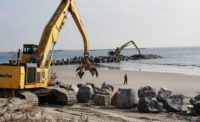The U.S. Army Corps of Engineers has tentatively selected a plan for projects aimed to manage coastal storm risk around New York City's harbor and its various tributaries around New York and New Jersey.
In a newly released draft report, the agency that the plan would have greater benefits than other considered options—including a controversial one that would have included construction of a gated seawall between Sandy Hook, N.J. and Queens, N.Y.
The preferred plan, developed by the Corps New York district with an estimated price tag of $52.6 billion, is set to include building breakwaters and seawalls that would cost $17.9 billion, and levees and floodwalls that officials estimate to cost another $14.1 billion. Planning, engineering and design costs will total about $5.7 billion, the report estimates, with a $1.5-billion price for construction management. Other significant anticipated costs include land acquisition and relocations.
The Corps says the federal government would cover 65% of the cost, with a 35% local share. Officials anticipate construction would begin in 2030 and last about 14 years.
“This is a significant milestone as we move towards a more resilient New York and New Jersey coastline,” Col. Matthew Luzzatto, district commander, said in a statement.
The Corps district's draft integrated feasibility report and Tier 1 environmental impact statement was drafted in cooperation with the New York State Dept. of Environmental Conservation and New Jersey Dept. of Environmental Protection, plus other New York City and state officials. The district released the report Sept. 26.
The plan calls for storm surge barriers or other shore-based measures around lower Manhattan and along the Harlem River, at the Newtown Creek between Brooklyn and Queens, in Brooklyn’s Red Hook area, across Flushing Creek in Queens, and in areas around Jamaica Bay including southern Brooklyn and the Rockaway Peninsula in Queens.
Measures also are proposed for both ends of the tidal straits between Staten Island and New Jersey and along the Hudson River shorefront of Jersey City, N.J. Other risk reduction features would be added along Newark Bay and the Hackensack and Passaic rivers in New Jersey, in parts of Jamaica Bay in Queens and in Nassau County, N.Y.
With the report release, the Corps has also opened a public comment period that ends Jan. 6, 2023.

The report has been in the works for several years. It faced a setback after former President Donald Trump withdrew funding for the study in 2020, criticizing the cost and environmental impact of the larger Queens-Sandy Hook seawall option, which the Corps had estimated would have cost $119 billion to build.
That plan also faced opposition from environmental advocates and others who raised concerns that the wall would only protect against storm surge, and do nothing to defend against the global sea level rise due to climate change.
The Biden administration restored funding for the study in 2021. The tentatively selected alternative has drawn more support from environmental groups such as Waterfront Alliance. Tyler Taba, its senior manager for climate policy, said in a statement that the group is pleased to see the Corps move to a hybrid approach of green and gray infrastructure solutions.
“We continue to echo our support for a phased approach that incorporates more natural and nature-based features,” Taba said. “We particularly encourage a closer look at buyouts, restored natural areas, elevation or relocation of infrastructure and non-physical nonstructural measures.”
The tentative plan also has the greatest estimated net economic benefits—$3.98 billion annualized over 50 years—among the considered options, according to the report. It would also decrease annualized costs of damages more than the large seawall option would. In a scenario with intermediate sea rise, the Corps estimates $7.9 billion in annualized damages with no action. Those damage costs would be reduced to $3.4 billion with the Queens-Sandy Hook seawall, or $1.7 billion with the tentative plan.
Following the public comment period, the Corps will take feedback to develop a final report, which is due to be released by June 15, 2024. The project will also hinge on Congress approving funding for the federal share of costs.






Post a comment to this article
Report Abusive Comment